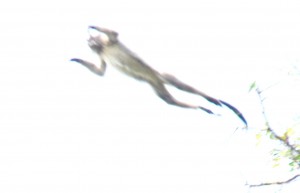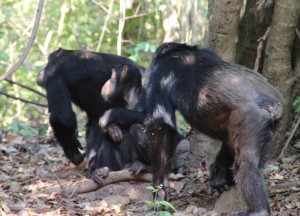In chimpanzees, intergroup aggression and hunting look quite similar in several ways. Both hunts and intergroup attacks are mainly the business of males. In both cases, groups of males climb, leap, and run after a victim, which, if they catch, they will bite and pummel until it stops moving. Attacking males bristle their hair like fighting cats, making them look even bigger than they really are. They bare their teeth in fearful grimaces and scream.

Since the 1970s, researchers have speculated that hunting and fighting in chimpanzees are related, resulting, perhaps, from the same psychological mechanisms. For example, chimpanzees’ close relatives, bonobos, have not been observed to kill other bonobos, and bonobos rarely hunt. Perhaps the two behaviors are linked? For example, my thesis advisor Richard Wrangham has speculated that as bonobos evolved from a chimpanzee-like ancestor, “males lost their demonism, becoming less aggressive to each other. In so doing, perhaps they lost their lust for hunting monkeys, too.” (Wrangham & Peterson 1996: 219)
Ten years ago, when I was a post-doc with Anne Pusey, in the early stages of extracting records on intergroup aggression from the long-term data at Gombe, I looked at seasonal patterns of intergroup encounters, as part of an effort to understand why such encounters occurred. From the limited sample of years for which I’d extracted data, intergroup encounters occurred most often in the late dry season (September and October) with a smaller spike in the middle of the wet season (February). When I compared notes with Anne’s graduate student, Ian Gilby, I was struck that he had found essentially the same pattern with hunts: the number of hunt attempts per follow peaked in the late dry season and mid wet season. Additionally, comparing five years for which we both had data, we found that years with more hunting success also had more patrols. Was this because hunting and intergroup fighting were caused by the same factors?
We agreed we should work on this further, and now that work has born fruit: a forthcoming paper in Animal Behaviour by Gilby, Wilson and Pusey.

A key inspiration for this work was one male chimpanzee, Frodo. Frodo was the best hunter at Gombe when Ian was doing his dissertation research. Frodo was involved in all four intergroup killings that I described in my first Gombe paper (Wilson et al., 2004). I had watched video, frame by frame, of Frodo brutally attacking a young male chimpanzee from the Kalande community. Maybe Frodo was a great hunter because he was a great fighter? Frodo was also exceptionally persistent in pursuit of estrous females, and genetic studies found that Frodo had fathered more babies than any other Gombe male. I began to wonder if in chimpanzees, hunting and fighting were both byproducts of selection for skills needed to achieve mating success.

Ian kept Frodo very much in mind when he went on to work as a post-doc with Richard Wrangham on data from Kanyawara. Ian proposed that a key part of group hunting in chimpanzees was the presence of particular individuals who really liked to hunt – which Ian termed “impact males.” As a group-level activity, hunting suffers from potential collective action problems. Hunting is risky and dangerous. Red colobus monkeys don’t want themselves or their babies to get eaten, and they fight back fiercely, biting with their sharp teeth. Individuals therefore might be tempted to free-ride – let others do the hunting, and then get meat afterwards, by begging, stealing, or scavenging what’s left when others are done eating. But if everyone free-rides, no one will hunt. So how does hunting get started? Ian proposed that some individuals, the impact males, are strongly motivated to hunt – and once they get started, others are encouraged to join in, because the costs of joining a hunt already in progress are less than the costs of starting the hunt.

The logic of “impact males” made sense to me, not only for hunts, but also for territorial behavior. Patrolling boundaries is energetically expensive and potentially dangerous, as patrols can meet a big group of hostile neighbors. Patrols therefore seem vulnerable to the same collective action problems as hunts. So maybe they are solved the way: some individual males are strongly motivated to go on patrols, reducing the costs for everyone else to join in. After all, if I know at least one of my buddies is going on patrol, I know I won’t be alone at the edge if I go with him. And perhaps – maybe these are all correlated for the same reason? Maybe the same males are impact hunters and impact patrollers? And maybe these same males are the ones who are really good at winning dominance interactions, gaining high rank, and getting access to fertile females and fathering lots of babies? Maybe these are all correlated traits, parts of an overall personality profile or behavioral syndrome of what it takes to be a successful male chimpanzee?
We now had lots more data to work with than we did a decade ago: 32 years of data on both hunting and boundary patrols. And we found that hunting and patrolling boundaries were indeed correlated, not just on a monthly basis, but also on a daily basis. However, it turned out that hunting and patrolling were mainly correlated because of the influence of other variables. Both hunting and patrolling were more common when males were in large parties – which we expected, because parties with more males are more likely to succeed, both in hunts and in intergroup encounters. But the main reason hunting and patrolling were correlated was because both involved long-distance travel. When chimpanzees patrol their borders, they necessarily travel a long ways. And when they travel a long ways, they are more likely to encounter monkeys.
We found that there were indeed impact males for both hunting and patrolling. But only one of the males who was an impact hunter was also an impact patroller. And surprisingly, good old Frodo was neither an impact hunter nor patroller. He had a positive impact on hunting probability, but not enough to merit status as an impact hunter. And the probability of patrolling was the same, with and without Frodo in the party.
So these results suggest that hunting and fighting, despite their many resemblances, may result from different psychological mechanisms. In some ways this is not really surprising, given that in species whose brains have been studied in detail, such as rats and cats, aggression and predation involve quite different regions of the brain. Additionally, Marissa Sobolewski has looked in detail at the hormones of male chimpanzees from the Ngogo community, going on two different kinds of patrols: hunting patrols, in which males are looking for monkeys, and border patrols, in which males are presumably looking for neighbors. Marissa found that testosterone levels were elevated for border patrols, but NOT for hunting patrols. This strongly suggests that hunting and fighting do indeed result from different psychological mechanisms in chimpanzees.
Our findings from the long-term data are thus rather different from what we thought we’d find. This illustrates the importance of looking at data, not just theory, when doing science. It’s easy to fall in love with hypotheses, but they need to stand the test of empirical work. Nonetheless, I still suspect there may be interesting links in the psychology of hunting and fighting. For example, tendencies towards pugnaciousness and risk-seeking seem likely to benefit both hunting and fighting (and acquiring mates). But from the data we’ve examined so far, being a top hunter doesn’t automatically make one an influential boundary patroller.
(For more on Frodo, see Ian’s biography of Frodo, Lisa O’Bryan’s description of Frodo in retirement and this picture of baby Frodo.)
